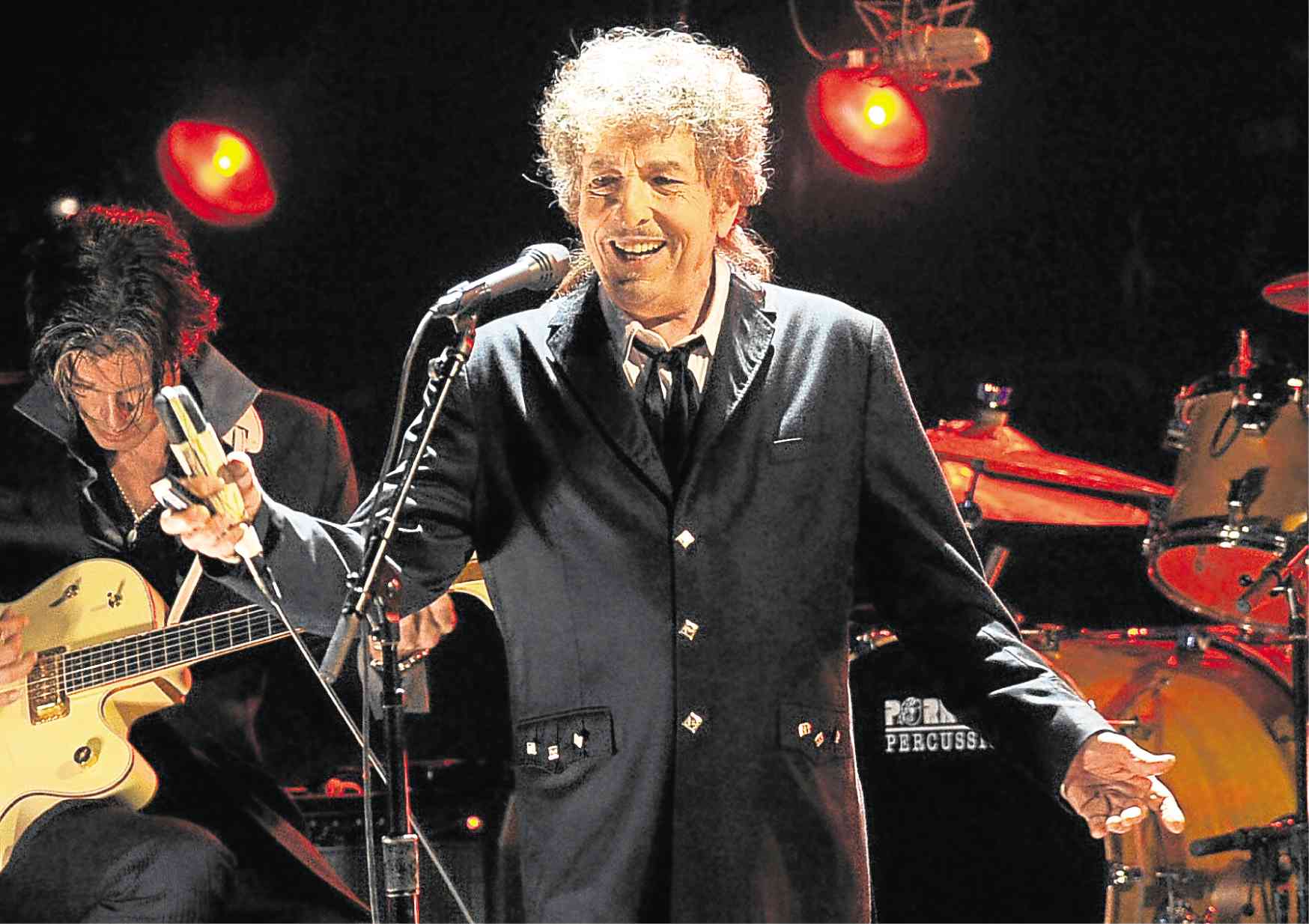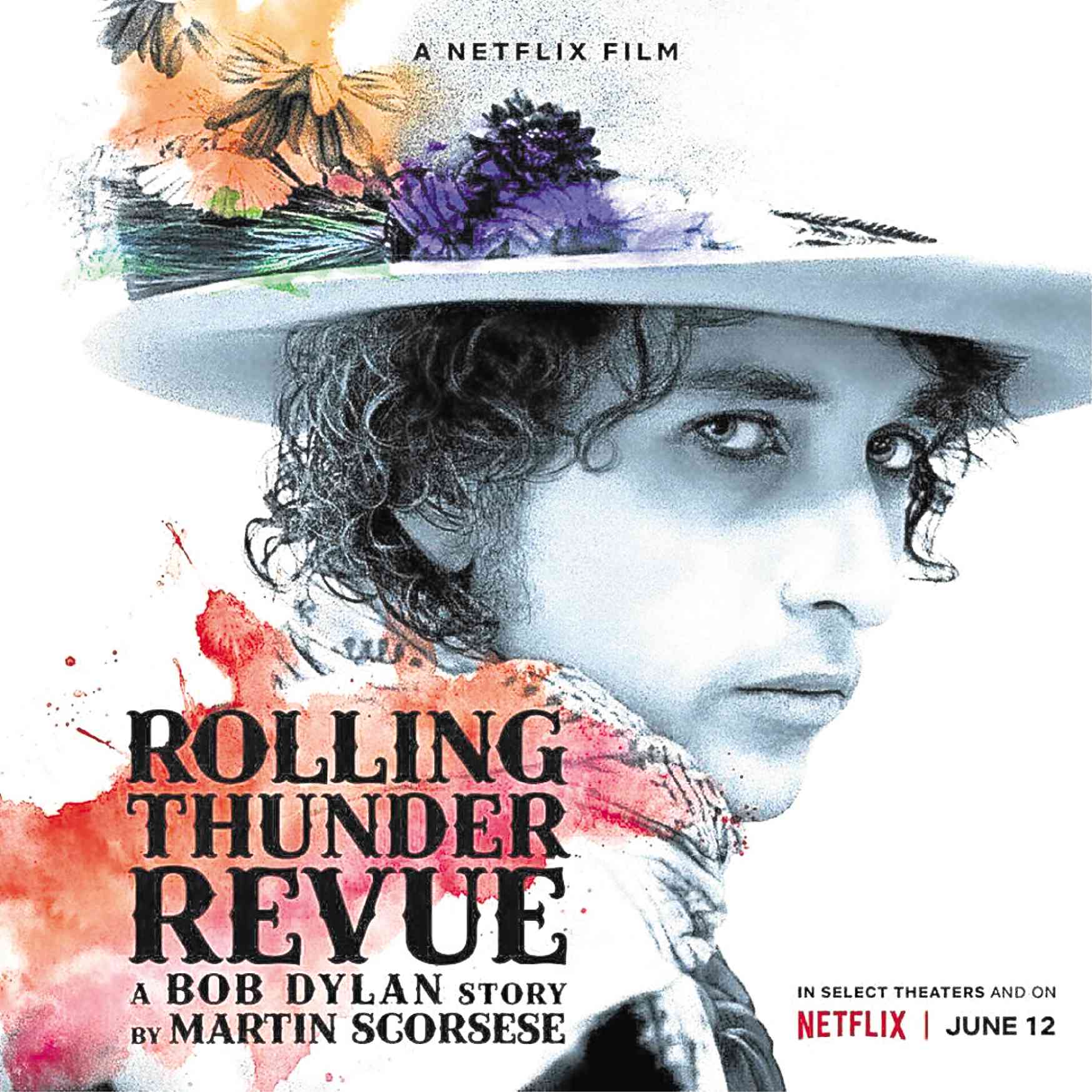
From Hollywood to hip hop, Filipinos have been avid consumers of American pop culture, dating back at least to the post-WWII era.
Sinatra, Elvis, the Beatles, Led Zeppelin, the Sex Pistols, Madonna, Biggie and Tupac— successive global pop icons have all left their imprint and inescapable influence on Pinoy pop music.
There is, however, one yawning void in this borrowed pantheon: Where’s Bob Dylan?
One of the towering figures of the cultural revolution of the 1960s, Dylan was awarded the Nobel Prize in Literature in 2016 “for having created new poetic expressions within the great American song tradition.”
His 1965 hit “Like A Rolling Stone” is widely regarded by critics and fans as the greatest rock song ever written.
He has influenced virtually every major artist who followed him. (Bruce Springsteen, for one, was initially hyped as “the new Dylan.”)
And yet, it seems he’s hardly made a dent in Filipino pop consciousness.
Why not? It bugs me—big time.
With Martin Scorsese’s Netflix documentary “The Rolling Thunder Revue: A Bob Dylan Story” premiering last June 12, a new generation will likely encounter Dylan’s musical genius for the first time.
A 14-disc box set of music from the 1975 tour documented in the film, avidly awaited by Dylanologists worldwide, was also released the same week.
It seems as good a time as any to explore why Dylan never made it big in the Philippines.
‘Tom Dooley’
One of my more vivid memories from grade school was learning to sing the Kingston Trio’s 1958 hit “Tom Dooley” in music class. (Apparently, the appropriateness of teaching children to sing a murder ballad never came up in the faculty meeting.)
The point is, folk music— the radio-friendly, commercial kind—had pretty much seeped into popular consciousness in the early ’60s.
A few years later, songs by Peter, Paul and Mary and Judy Collins were being played on local radio. But although these artists looked up to Dylan as a key influence, his own songs rarely got airplay.
A couple of years later, scores of electric guitar “combos,” among them the Hi-Jacks, RJ and the Riots, and the Electromaniacs, were the big thing, a wave inspired by the popularity of instrumental groups like the Ventures and the Shadows.
Then came Beatlemania.
British Invasion
D’ Downbeats opened for The Beatles at the latter’s 1966 concert at the Rizal Memorial Stadium, making them our de facto analogue to the Fab Four. The Beatles concert ended in debacle when Marcos thugs chased them all the way to the plane at the airport after they reportedly declined an “invitation” to pay a courtesy call in Malacañang.
But by then, there was no end to Filipino bands playing music by The Beatles, and later, The Rolling Stones, The Animals, The Kinks and the rest of the British Invasion groups.
By the end of the ’60s, with the Beatles members going psychedelic (thanks in no small part to Dylan, who first turned them on to weed back in ’64), Pinoy tastes took a turn for the heavier.
Local bands took their influences from hard rock acts such as Jimi Hendrix, Cream, Black Sabbath and Led Zeppelin. Heavy blues rock formed the template for what was to become “Pinoy rock” just a couple of years later.
By this time, Dylan had abandoned protest song for rock ’n’ roll, and had made his most sonically adventurous records with Mike Bloomfield, Al Kooper and the Band: “Bringing It All Back Home,” “Blonde on Blonde,” “Highway 61 Revisited.”
For some reason, these albums never got significant airplay here. Even the so-called “underground” radio stations preferred hard rock—and later, mellower country rock—to classic Dylan.
Woodstock found its analogue in the 1970 Antipolo Rock Festival, which featured D’ Downbeats, the nascent Juan de la Cruz Band and the unforgettably-named T. Tinio Band.
It was a seminal moment for the emerging local counterculture. A lot of Santana was played, but still no Dylan.

‘Blowing in the Wind’
The First Quarter Storm (FQS) of 1970, just nine months earlier, was really the time when Dylan should have taken off. “Blowing in the Wind” was the anthem for the global protest movement sparked by the Vietnam War and the American civil rights movement, which soon spread to Europe and the rest of the world.
Initially, the student activists of the FQS did sing “Blowing in the Wind,” “The Times They Are a-Changin’” and other songs by protest-era Dylan, but as attitudes hardened with government repression, these were soon replaced by “Bangon” (The Internationale) and other Filipino revolutionary anthems at the barricades.
Activists dug Dylan the protest singer, but they didn’t quite get Dylan the surrealist poet.
One activist friend’s reaction was typical: “I liked Bob Dylan when I could understand what he was singing about.”
Meanwhile, if Dylan songs were sung at all in the local folkhouses, it was more likely the “sweetened” cover versions that were themselves covered: Peter, Paul and Mary’s version of “Blowin’ in the Wind,” or the Byrds’ folk-rock rendition of “Mr. Tambourine Man.”
Local folkies were more likely to sing Simon and Garfunkel than Dylan. The local folkie anthem wasn’t “Blowin’ in the Wind”, it was “The Boxer.”
Pinoy folk
Pinoy folk emerged in the wake of Pinoy rock’s decline in the late ’70s with such artists as Asin, Freddie Aguilar and Heber Bartolome and Banyuhay. With the new nationalistic bent and the emphasis on expressing a Filipino identity, artists wanted to move away from Western influences.
If Dylan influenced local music at all, it was obliquely, when artists emphasize the lyrics and topical content, for instance.
There are any number of theories as to why Dylan never made it big in the Philippines, the way other artists of similar stature did.
Literary
Dylan’s use of language, so central to his art, doesn’t really translate. His writing drew on a number of literary influences, including Arthur Rimbaud, T.S. Eliot and Allen Ginsberg, as well as traditional American folk and blues, and early on, Woody Guthrie.
Imagine, if you will, a local band trying to sing “once upon a time you dressed so fine, threw the bums a dime in your prime, didn’t youuuu!!!”
Dylan’s voice, memorably described by writer Joyce Carol Oates as “frankly nasal, as if sandpaper could sing,” is also an acquired taste.
“Dylan was more of a writer,” recalls Hoagy Pardo a.k.a. Cousin Hoagy, former DZRJ DJ, who confirms Dylan’s lack of local radio exposure: “Wonderful lyrics and melodies. The Grateful Dead and Jimi Hendrix made his songs theirs. But how many young listeners would appreciate Dylan’s gravelly vocals?”
Chickoy Pura, who cut his teeth as a folk musician before becoming frontman of The Jerks, says audiences are more familiar with “the James Taylor type” of singer.
“It’s hard to keep up with Bob Dylan,” he adds.
The ’70s Bistro used to hold a regular “Beatles Night,” during which local bands covered asn many Beatles classics. In contrast, as far as I recall, they only ever had one “Bob Dylan Night,” which has never been repeated.
The thing is, artists who draw from the Bob Dylan songbook—and there have been quite a few, from Joan Baez and Peter, Paul and Mary to Joan Osborne and Bryan Ferry—succeed when they make the song their own, by singing in their own voices.
As far as I know, no local artist has done that yet. But it doesn’t mean no one will.














































